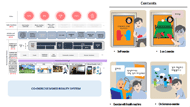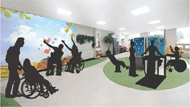INTRODUCTION
Annually, 795 000 people in the United States experience a stroke[1]. Stroke survivors were found to be restricted over a wide range of domains but the greatest disadvantage occurred in the domains of mobility, physical independence and occupation[2]. In the meantime, many assistive technology devices and services have been introduced for stroke survivors, but they have not been successful. In fact, only one third of stroke survivors succeeded in returning to the community in 2014 in South Korea[3]. High-quality interactions that enable an individual customer to co-create unique experiences with the company are the key to unlocking new sources of competitive advantage[4]. It is not easy to find out people’s real needs. What people experience is often determined by tacit knowledge or latent needs and is often difficult to express in words[5]. Design council in UK introduced a double diamond method as a new design thinking method in 2007[6]. The double diamond method is often used as a customer participation model. Clune and Simon[7] developed environmental sustainability strategies using the double diamond method. The aim of this study is to plan co-exercise mixed reality system for stroke survivors using design thinking (double diamond) method.
METHODS
Design and Procedure

Participants

RESULTS
Discover

Define

Develop 1: Value-based ICF assistive technology development framework

Develop 2: Co-exercise mixed reality system

Deliver
The co-exercise mixed reality system for stroke survivors in community setting is shown in Fig 6. There are various types of community services and service funding systems in Korea. We proposed Business to Business model at the day care center and the welfare center for stroke survivors, and it is also possible to expand into the area of people with disability and the elderly. An eco-system that connects the game developer, service provider, and consumers is also introduced. Also, the users can check my exercise situation through the game cloud and form a social network.
DISCUSSION & CONCLUSION
In this study, we planned and developed co-exercise mixed reality system for stroke survivors using design thinking (double diamond) method. During the design thinking procedure, we found out core values of stroke survivors, persona and their customer journey map. Also we set up Value-based ICF assistive technology development framework using ICF and core value. This new framework provides the basis for simultaneously thinking about ICF and core value in developing assistive technologies. Also when the co-exercise mixed reality system for stroke survivors is introduced, medical costs and indirect costs (depression and social isolation) are expected to decline due to social reintegration of stroke survivors.
REFERENCES
1. Billinger, S.A., et al., Physical activity and exercise recommendations for stroke survivors. Stroke, 2014. 45(8): p. 2532-2553.
2. D'alisa, S., et al., How does stroke restrict participation in long‐term post‐stroke survivors? Acta Neurologica Scandinavica, 2005. 112(3): p. 157-162.
3. Kim, D.A., Preliminary study for designing social reintegration support program for people with stroke based in the hopital. 2014: National Rehabilitation Center.
4. Prahalad, C.K. and V. Ramaswamy, Co-creation experiences: The next practice in value creation. Journal of interactive marketing, 2004. 18(3): p. 5-14.
5. Visser, F.S., et al., Contextmapping: experiences from practice. CoDesign, 2005. 1(2): p. 119-149.
6. Council, D., Eleven lessons: Managing design in eleven global companies-desk research report. Design Council, 2007.
7. Clune, S.J. and S. Lockrey, Developing environmental sustainability strategies, the Double Diamond method of LCA and design thinking: a case study from aged care. Journal of cleaner production, 2014. 85: p. 67-82.
8. Rokeach, M., The nature of human values. 1973: Free press.
9. WHO, International Classification of Functioning, Disability and Health: ICF. 2001: World Health Organization.
10. Geyh, S., et al., ICF Core Sets for stroke. Journal of Rehabilitation Medicine, 2004. 36(0): p. 135-141.